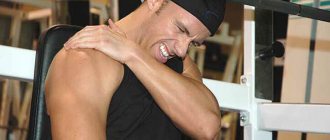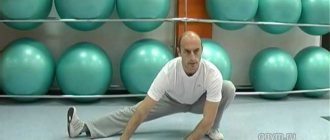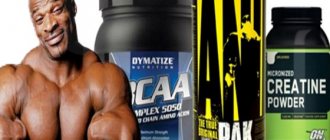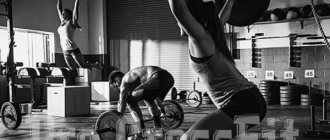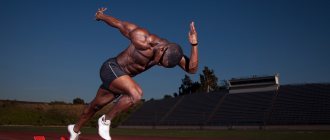Description and differences
Aerobic exercise or cardio training is a set of exercises to improve the functioning of the cardiovascular system. It also helps people lose weight and increase the body's endurance levels by actively strengthening the heart muscle.
At that time, anaerobic type of physical activity, despite the consonant name, serves to build and strengthen the muscles of the whole body.
The main differences between aerobic and anaerobic exercise:
- Cardio training includes leisurely exercises that also train agility: for example, aerobics, dancing, slow running over long distances. And strength loads are effective only when quickly and systematically performing strength tasks: fast running, bodybuilding, etc.
- Strength exercises involve working with special heavy sports equipment or on simulators, while for anaerobic exercises it is not necessary to stock up on certain equipment.
- Intensity is also important: while cardio training should be done slowly, anaerobic exercise is a high-intensity sport.
Principles of Aerobic Exercise
1. Development of the muscles responsible for breathing, as well as the heart muscle, due to the rhythmic performance of various types of body movements for a long period of time, which improves the supply of oxygen to tissues and normalizes the pulse.
2. Development and strengthening of skeletal muscles due to the need to regularly stabilize your balance during exercises, at different paces.
3. Improving the psycho-emotional state, combating stress due to the rhythm of exercises, the release of serotonin into the blood. The better the mood, the higher the body's endurance. Aerobics, shaping, dancing, step aerobics, group cycling training, and Zumba are perfect for combating depression.
4. Conduct twenty-minute classes at least three times a week! Otherwise, the result will be imperceptible. If desired, training can be done more often.
What is aerobic fat burning training?
First of all, in addition to burning fat, cardio training has enormous benefits for the entire body:
- They help develop stress resistance (this point especially applies to people prone to strong emotions).
- Improves endurance indicators.
- They increase bone density throughout the body, i.e. reduce the risk of fracture.
- They protect against diabetes and also reduce the risk of cancer.
- They help fight insomnia and other sleep disorders, which means your brain activity increases during the daytime.
- Due to targeted action, they inhibit the aging of the body.
However, people who want to lose weight with the help of cardio exercises need to remember the main rule: fat burning begins no earlier than 25 minutes after the start of exercise. During the first 20 minutes, under the influence of enzymes, glycogen is broken down - a reserve carbohydrate stored in the body in case of deficiency. And only then the body begins to lose fats and proteins.
To effectively lose weight, you should exercise at least 40 minutes a day, and also remember about proper nutrition: without it, aerobic training can harm the body.
Let's take protein as an example. One of its functions is construction. It serves as one of the materials on which the muscles are held. During cardio training, protein is broken down and muscles weaken. To prevent this, you need to drink a lot of still water and eat protein foods. The process of losing weight will not stop, and the muscles will receive the fuel they need to function properly.
To ensure that the body does not stop responding to attempts to lose weight, you need to combine cardio training with strength training, and also remember that aerobic exercise is safe only for an hour, then it harms hormonal levels.
In some cases, you can take adaptogens, such as ginseng. They affect energy metabolism in the body.
Aerobic exercises at home
Everyone has the opportunity to perform such gymnastics at home. This does not require exercise equipment or a lot of space. Exercises should be selected based on the size of the room where you will practice and your physical fitness. The optimal duration of classes at home is 45-60 minutes. Cardioaerobics consumes energy from the breakdown of oxygen, carbohydrates and fats. First, carbohydrates are broken down, fat burning begins after 20-30 minutes. From the start of classes, there is no point in making the workout shorter.
Aerobic exercises at home are performed to rhythmic music. You can combine them, diversify the activities with different variations - the main thing is that you enjoy it. All exercises are performed intensively, as if under the supervision of a strict trainer. Here are some basic aerobic exercises for training at home:
- running in place and jumping;
- jumping up;
- squats, stretching exercises;
- jumping up while lying down;
- kicks;
- elements of dance, step aerobics.
What is anaerobic training
During strength training, ATP synthesis in muscles occurs without the participation of oxygen, which entails a huge expenditure of muscle energy. This result is achieved thanks to the intensity and speed of the loads.
Anaerobic exercise has many benefits for the human body and body:
- They convert fat cells into muscle, causing muscles to grow and the body to look toned. However, most women should not be afraid of excessive weight gain: due to the different hormonal structure compared to men, muscles will only grow to a certain stage.
- Strengthens the body and spine.
- Correct your posture.
- They increase the body's resistance to climate change and also improve immunity.
- Helps a person feel invigorated.
It must be remembered that training should take place very quickly, with short breaks between approaches. It is advisable to use heavy sports equipment such as dumbbells or barbells.
Types of Aerobic Exercise
Leisurely cycling, aerobics, slow running over long distances, dance exercises, race walking and even swimming - all this can be classified as cardio training. The optimal time for classes is considered to be from 30 to 60 minutes.
However, not everyone has the opportunity to devote time to sports outside the home. Therefore, there are some aerobic exercises that can be performed at home.
- Walking with shin overlapping. Try to make sure your calves reach your buttocks.
- Raising your knees to your chest. Don't forget about your posture.
- Lunge back with knees raised to chest. The leg that rests on the floor must be kept at a right angle to the floor.
- "Boxer". Place your feet shoulder-width apart, bend your knees slightly. Imagine that there is a punching bag in front of you and start hitting it with your fists as hard as you can.
- Walking in a plank position. To begin, stand up straight and get ready. Then slowly, being careful not to bend your legs too much, lower yourself into a plank position while walking with your arms outstretched, then return to the starting position and repeat.
- Stand in a plank position with your arms outstretched, and alternately spread your legs to the sides, returning them to their original position.
Any anaerobic exercise is suitable for burning fat.
Execution Rules
- Make a daily plan consisting of several circles, each of which you start at least twice. Include a different exercise in each circuit. Take a minute break between circles.
- Spend no more than 30 seconds on one approach, after which take a break of 10-15 seconds.
- Always exercise in sneakers. Lack of comfortable sports shoes can lead to joint problems. It is also recommended to create a cozy and calm environment so that there are no distractions.
- Don't forget about warm-up and cool-down.
- Take breaks between sets.
- Keep your posture straight and your stomach pulled in.
- Look straight ahead unless there are other instructions for the exercise.
- Gradually increase the duration of your workouts.
Aerobic exercise for older people
- Head tilts left, right, back and forward. In this case, you need to keep your feet shoulder-width apart, and try to straighten your back as much as possible.
- Rotation of the upper body.
- Lower body rotations.
- Long walks. Nordic walking (fast walking with ski poles) is also suitable.
- Slow bending forward while touching the floor helps to warm up the muscles and relieve lower back pain. It is important to keep your legs and back straight.
How to train correctly
There are several points to consider during aerobic training:
- The intensity of classes is determined depending on the physical condition of the person. At first it is very difficult to tune in to the desired level and quantity. But gradually your endurance will increase, which will allow you to train fully. For beginners, 20 minutes of aerobics daily is enough. Before exercising at home, it is necessary to warm up.
- We select the right load. The most popular exercises available to all trainees are running and walking. Walking is especially recommended for people who have problems with their knee joints.
Note. If there are no health problems, it is best to exercise in the form of running. But it is important to do this for 40 minutes. It is within this time frame that fat burning can be activated.
- Cycling is another type of aerobic physical activity that is definitely worth paying attention to. It can be easily combined with pleasant walks with loved ones. If you are tired of boring runs alone or monotonous walking on a treadmill, then a bicycle is the best option.
- For those who find it difficult to tune in to independently compiling and performing a set of exercises, aerobics classes based on video lessons and videos on the Internet are suitable. There are a lot of interesting programs that will not only train the body, but also lift your spirits.
- During classes, be sure to monitor your diet. It is best to give up junk food, fatty, salty, starchy foods. Let's switch to proper nutrition. This will allow you to feel lightness throughout your whole body much faster.
Duration of aerobic training, optimal heart rate
The heart rate or heart rate during exercise should not increase by more than 85 percent of the normal heart rate. To calculate the exact number of heart rates that will not harm the body, there is a special formula:
Optimal heart rate = (220 - your age - average resting heart rate) * (percentage intensity / 100%) + resting heart rate.
The duration of aerobic training should not exceed 60 minutes. Otherwise, there may be problems with hormones.
Anaerobic exercise
As we said above, this is mainly a force load on the body. Your daily sports routine may include the following exercises:
- Running up and down the stairs.
- Run quickly on incline or level terrain for thirty seconds.
- Push-ups from the floor, walls, benches (women are recommended to do push-ups from a bench).
- Pull-ups.
- Lifting and pressing a barbell that is suitable for you. After achieving a certain result, it is necessary to increase the weight of the projectile and the speed of the exercise.
- Squats with a projectile. You can even use bags of sand or potatoes.
- Lunges with dumbbells or barbells.
- Overhead barbell press.
- Leg raises on the horizontal bar. Helps pump up your back and abs.
- Plank on extended or bent arms.
Anaerobic training rules
- Regularity.
- Speed.
- Exercising loads on each muscle group.
- Warm up and cool down, which can be stretching exercises.
- Comfortable sports suit.
- Straight back.
- Even breathing.
Which is better, an exercise bike or a treadmill?
If your aerobic workout is limited in time, say up to 30 minutes , then it is recommended to use exercises that involve large muscles in their work. These workouts provide greater oxygen consumption, or VO2 max , which is the main benefit of aerobic training. Another option is to simply your aerobic exercise more challenging
Increasing your speed on a treadmill will not only be a more effective method for toning your thighs and buttocks, but will also cause greater oxygen consumption than riding a stationary bike.
Back in 2003, scientific studies were carried out, which were published in the journal “Medicine and Exercise in Sports”, in which they compared the oxygen consumption of muscles when performing a load on the VersaClimber , in which the load is applied not only to the legs, but also to the hands, and a treadmill with a rowing machine. As a result, it turned out that the VersaClimber simulator consumes much more oxygen than all the others. This shouldn't surprise you because the VersaClimber works both your upper and lower body muscles at the same time.
Which is better, an exercise bike or a treadmill?
How to replace a treadmill?
In another study, scientists looked for an alternative aerobic exercise that could fully replace the treadmill. And it turned out that roller skating , while maintaining your heart rate at 75% of your maximum, is comparable to walking on a treadmill, at the same intensity . That is, in both cases you will receive the same benefits from aerobic training.
Alternative replacement for a treadmill
Why is it harmful to run near a road?
We have practically no free space left, especially within the city, where there would be no motor transport . Because of this, it is not possible to run in open space, on the street. There are, of course, “heroes” who run next to the road, with cars, thus “getting healthy”; this is extremely unreasonable .
Scientific research on this subject was carried out, and it turned out that such a “healthy” run is equivalent to smoking two packs of cigarettes, due to the frequent inhalation of car exhaust fumes.
Anaerobic glycolysis, anaerobic threshold and MIC
Anaerobic glycolysis is the process of breaking down glucose molecules without the participation of oxygen (which is what such training implies). This complex chemical phenomenon contributes to the transformation of most fatty tissues into muscle tissue, due to which a person acquires a sculpted body, and fat burning occurs more actively.
The anaerobic threshold is the maximum intensity of training that does not harm the body. If you cross this threshold, the content of lactic acid in the muscles will exceed the permissible norm, and the body will not have time to neutralize it.
MOC or maximum oxygen consumption is the largest number of milliliters of air that a person consumes in 1 minute. Monitored in aerobic exercise.
Myth #4: Lactic acid is bad
Not really. The unbearable burning sensation in your muscles during a hard workout is caused, according to experts, by a buildup of lactic acid. It is formed in the muscles during high-intensity exercise. In this case, skeletal muscles need a lot of energy, and as quickly as possible.
Recharge of the muscles involved in training is carried out by various energy delivery systems. One such system, the one that produces lactic acid, is called the glycolytic system because it uses the breakdown of glycogen to provide energy to muscles. If there is no lack of oxygen, pyruvic acid is formed. However, if high intensity exercise results in insufficient oxygen supply (for example, during a 100-meter race), lactic acid is produced. Its accumulation apparently leads to muscle fatigue.
The accumulation of lactic acid is one of the factors limiting the effectiveness of training. The intensity of exercise at which lactic acid begins to rapidly accumulate is called the “lactate threshold.” Experienced marathon runners know that by keeping their pace just below lactate threshold, they will avoid muscle fatigue caused by lactic acid.
There is an opinion that if two athletes have the same VO2max (read here what VO2max is and how to find out your threshold), then the athlete with a higher lactate threshold (i.e. the one whose lactate threshold is at a higher intensity level in exercises) has an advantage over the opponent.
This is the classic view of lactic acid (“lactic acid is bad because it limits effectiveness”). However, it is not entirely correct to consider lactic acid as “bad” by definition. There is a more recent and relevant view of this phenomenon.
Back in the early 1970s, exercise physiologist George Brooks expressed a slightly different opinion regarding lactic acid. He discovered that muscle cells use lactic acid as an energy source. For many years, his theory met only with disapproval from the scientific community. It is now known that as a person's fitness improves, muscle cells (especially the mitochondria within muscle cells) adapt to using more lactic acid as fuel.
That is, there is a logical explanation why athletes and coaches consider the formation of lactic acid to be a “bad” phenomenon. But this is an important process and it can also have its positive sides.
Options for complex training of aerobic and anaerobic exercise
Of course, the greatest effect can only be achieved with a combination of cardio and strength training. Depending on your goals, you can focus on both the first and second options.
If your goal is to lose weight, then mixed training with an emphasis on aerobic training is suitable for you. Experts advise alternating types of sports activities by day or time of day to achieve greater results.
If you want to work on body contour, you should devote more time to anaerobic exercises than aerobic ones. However, cardio training is necessary in any case if you do not want to develop problems with the musculoskeletal system.
Please note that it is under no circumstances recommended to combine them at the same time. It is better to do aerobics in the morning and run a hundred meters at speed in the evening, or vice versa.
But the most important thing is to remember the routine and that even a short workout helps pump up your brain and your torso. And in order not to quit, remember why and why you started classes.

